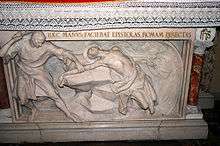Pataria

The pataria was an eleventh-century religious movement in the Archdiocese of Milan in northern Italy, aimed at reforming the clergy and ecclesiastic government in the province and supportive of Papal sanctions against simony and clerical marriage. Those involved in the movement were called patarini (also patarines or patarenes, from singular patarino), a word chosen by their opponents, which means "ragpickers", from Milanese patee "rags". In general the patarini were tradesmen motivated by personal piety. The conflict between the patarini and their supporters and the partisans of the simoniacal archbishops eventually led to civil war by the mid-1070s, the Great Saxon revolt. It received its most dependable contemporary chronicler in Arnulf of Milan.
The pataria was partially the result of church reform movements like the Peace and Truce of God and partially of the social situation in Milan. The influence of southern French movements, such as the Peace and Truce, affected the pataria. The subsequent popularity of the Cathar movement in Milan during the twelfth century was resultant of the pataria. The chief targets of the patarini were the rich, secular, aristocratic landowners and the simoniacal and nicolaitan clergy. They contested the ancient rights of the cathedral clergy of Milan and supported the Gregorian reforms. They joined with the lesser clergy in opposition to the practices of simony and of clerical marriage and concubinage. The morals of the clergy were attacked, too, as was monastic discipline. The contrast between the impoverished lesser clergy and the magnates of the Church resurfaced as a point of contention.
The archbishop Guido da Velate was a particular victim of the patarini. On the death in 1045 of the warrior and prince-bishop Ariberto da Intimiano, the Milanese requested the Emperor Henry III, who controlled the election of bishops in his realms, to choose from among four candidates deemed retti ed onesti (upright and honest): Anselmo da Baggio, Arialdo da Carimate, Landolfo Cotta, and Attone. The Emperor's choice, however, fell upon the thoroughly worldly Guido, known for his support of the practice of clerical marriage and concubinage, which was generally accepted in rural areas and which was now being given the name "nicolaism", recalling a passage in the Book of Revelation (2:6, 14–15).
Guido, however, did not fulfill his vows to fight simony and was forced to resign. The patarini initially protested the abuse by their refusal to accept communion at the hands of priests with unofficial wives or concubines. Some churches were emptied while others were packed with the faithful. The movement formed behind its leaders, the four rejected "upright and honest" priests. To defuse the situation the emperor named Anselmo da Baggio bishop of Lucca, which carried him securely away from Milan, and the archbishop excommunicated the intractable Arialdo da Carimate and Landolfo Cotta.
Following the pontificate of Benedict IX, the papacy too began to sense the urgency of reform and Pope Leo IX condemned both the practice of simony and concubinage among priests. When Landolfo Cotta attempted to present the position of the Milanese patarini before Pope Stephen IX, the archbishop's ruffians caught up with him at Piacenza and came near to killing him. A second attack in 1061 was successful. In 1060 Pope Nicholas II sent a delegation to Milan under the direction of Peter Damiani and Anselmo da Baggio, and calm was restored to the city.
After Landolfo's death, his brother Erlembald stepped in to take his place. He transferred the movement from one primarily socioreligious to principally military. The pataria at this moment received the support of Popes Alexander II and Gregory VII while the Ambrosian see fell into schism and war until the archiepiscopate of Anselm III reestablished order.
The Occitan word pataric later became a synonym for Cathar. The wife of the troubadour Raimon Jordan was a reported pataric. There were also rumours, emanating from a Christian prisoner in Alexandria, that the Patarenes had made an alliance with the Muslims against the Crusaders. These rumours captivated Joachim of Fiore, who built on it an apocalyptic theory of the union of the "beast from the sea" and the "beast from the land".
Sources
- Goetz, J. "Kritische Beiträge zur Geschichte der Pataria" in AKultG 12/1916, 17-55, 164-194.
- Jordan, K. "Pataria" in Religion in Geschichte und Gegenwart. V, 3.A., 150f.
- Jordan, William Chester. Europe in the High Middle Ages. Penguin Books, 2003.
- Roll, Eugen. Ketzer zwischen Orient und Okzident: Patarener, Paulikianer, Bogomilen. Mellinger: Stuttgart, 1978. ISBN 3-88069-190-8
- Dizionario Biografico degli Italiani. Rome.
- Les collections de l'histoire, no. 26, page 26.
- Coleman, Edward. “Representative Assemblies in Communal Italy”, in P.S. Barnwell & Marco Mostert (eds.), Political Assemblies in the Early Middle Ages. Turnhout, 2003. 193-210
- Cowdrey, H.E.J. Cowdrey. “Archbishop Aribert of Milan”, History 51, 1966. 1-15
- Cowdrey. “The Papacy, the Patarenes and the Church of Milan”, Transactions of Royal Historical Society, 5th series, vol. 18, 1968. 25-48
- Cushing, Kathleen G. “Events That Led to Sainthood: Sanctity and the Reformers in the Eleventh Century”, in Richard Gameson & Henrietta Leyser (eds.), Belief and Culture in the Middle Ages. Oxford & New York, 2001. 187-96
- Patschovsky, Alexander. “Heresy & Society: On the Political Function of Heresy in the Medieval World”, in Caterina Bruschi & Peter Biller (eds.), Texts and the Repression of Medieval Heresy. 23-41
- Siegel, Arthur. “Italian Society and the Origins of Eleventh-Century Western Heresy”, in Michael Frassetto (ed.), Heresy and the Persecuting Society in the Middle Ages: Essays on the Work of R.I. Moore. Leiden, 2006. 43-72
- Stock, Brian. The Implications of Literacy: Written Languages and Models of Interpretation in the Eleventh and Twelfth Centuries. Princeton, 1983